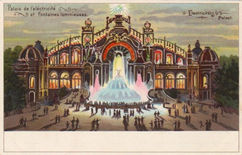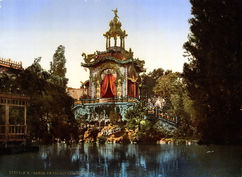
Room 02
The Asian Spin
at the World's Fairs
Picasso and Braque Go to the Movies, 2008.
Source: McNay Art Musuem
Motion: The Spirit of the Time
The spin of the Asian dance corresponded to the spirit of the time in Europe which, with the development of steam engine, celebrated speed and motion. The emphasis on dance interacted with an important philosophical shift at the time that again quickly gained a global following. "Movement" was discovered as the true characteristic of modern life, especially that of modern urban life, with its moving vehicles, motion pictures, gas and later electric lights that extended the day into night for work and leisure. It was claimed that these urban dynamics actually reflected the workings underlying the universe.


1894 illustration of the Serpentine Dancer: Loïe Fuller. William H. Bradley (American illustrator, 1868 - 1962).
A clip of Loïe Fuller from the documentary, Picasso and Braque Go to the Movies,
2008. Speaker: Tom Gunning, Film Historian.

When West Meets East
While concepts of “movement” as the spirit of
modern times quickly spread to Asia especially to the countries engaging in political and social reform like Japan and China, dance movements in the sense of dance forms also migrated to the west from Asian cultures through the world fairs. Dancers like Loïe Fuller are a prime example of the fruitfulness of these cultural encounters. Asian dance became an inspiration for modern dancers, it stimulated their imagination of modernity. Fuller’s famous sash dance with its swinging motions is an example. It might have been inspired by East Asian dancers performing at the world fairs. In the 1895 poster (on the right) we see a Vietnamese-Chinese dancer dancing with colored sashes with movements indicating swinging and turning. Such a silent migration of forms, gestures, and accoutrements is a common and often overlooked feature in cultural exchanges.




Dancing Girl.


Early film footage capturing dance as the embodiment of culture as "live motion."
Asia's Cultures as "Live Motion"
Dance, more than any other art form, created
an international language through which audiences around the world were able to communicate through aesthetic appreciation of other cultures. Asian dancers came to the different worlds fair between 1860 and 1900 sponsored by national governments (Japan. Korea), colonial governments (India, Cambodia, Java) or foreign advisors (China). The ultimate aim of their performances, however, was to present the best of the local cultural tradition. These dancers and their performances showed Asia's culture as live motion.


Advertisement posters featuring the American dancer, Loïe Fuller (1862 - 1928) at Folies Bergère.

Dancing Matter
into Motion: Loïe Fuller
The dancer who embodied the new spirit of motion and movement in Paris, the period's "capital of letters", was the American Loïe Fuller, at the time "the most famous dancer in the world.”[2] Her experimental spinning dances with stunning light effects and long silk bands were able to create magical illusions and beauty, of matter dissolving into energy. Her spin dancing and her usage of silk sashes show the effects of her encounters with Asian dance.



The Migration of Form
Dance forms migrate but this never is a question of simply copying. As they are seen and appreciated by dancers from other cultures, they act as inspiration to develop something new. The result will look quite different, but a careful study will reveal the traces of this inspiration.
The films that captured the dance movements of the three Japanese dancers (top, 1894) and of Loïe Fuller (bottom, 1900) both emphasize motion and the celebration of it. The motion of the silk sash in both dances give the dance its outer structure. In both dances, moreover, movements tend to be abstract instead of narrative. The Japanese dance resemble the very popular East Asia ribbon dance with silk being thrown into the air by the dancer. While Fuller’s dance steps suggest that they are indebted to tradition, her movement becomes abstract in form as the body of the dancer disappears in the motion of the silk cloth, leaving a moving image entirely formed by the whirling shape of the silk. The floral patterns in Fuller’s silk dance, furthermore, recalled the Japanese lily which was a dominant motif in the Art Nouveau movement. Fuller’s silk sash dance can be considered the emblem of “Art Nouveau style” of dance, and Art Nouveau sculptors, graphic artists, photographers, and porcelain decorators left and endless array of works depicting this dance of hers.

Exposition Universelle
Paris 1900
Beginning of Art Nouveau in Paris
Le Château d'eau, Exposition Universelle, 1900, Paris, France.
Source: Library of Congress's Prints and Photographs division
Paris, Dance,
and Art Nouveau
The Exposition Universelle of 1900 was a true and stupendous world’s fair. It was held in Paris to celebrate the achievements of the past century and to help speed up developments in the next. While the 1889 Paris Exposition for which the Eiffel Tower had been erected, was to inaugurate a modern style of technological innovation that demonstrated its possibility of creating cultural monuments with the materials of industrial production, the focus of 1900 Paris Universelle was on culture, especially in the field of art, crafts, and architecture. This fair, which attracted nearly 50 million visitors, displayed many machines, inventions, and architectural feats which have become universal household items such as the diesel engine, talking films, escalators, and the telegraphone (the first magnetic audio recorder), was also devoted to displayed the arts and cultures of foreign lands. As one critic declared that the 1900 Exposition is the Orient’s “grandest and brightest” expansion yet. Not surprisingly, much of the public interest in the Exposition was focused on the seemingly endless varieties of cultures that were available for sampling. From food and drink to cigarettes and postcards, everything made “the Other” accessible in an unprecedented fashion.[4]
One of the places where this exchange of culture took place was at the “Palais de Dance” which was established at the 1900 Paris fair and was devoted to dance from all over the world.




Movement Goes Global
Chinese shadow theater box with Loïe Fuller.
Source: Ancient Games Collection


P. Bineteau, Exposition universelle de 1900 - plan général.
Location of La Loïe Theatre
Sada Yacco
at the 1900 Paris Fair
Dancers like Loïe Fuller took inspiration from wherever they could find it, be it the latest discovery of Radium, Art Nouveau, American folk dance, or Asian dance. She was not alone. Asian dance became an inspiration of the imagination for many modern dancers. This imagination dominated the Exposition Universelle in Paris in 1900. Fuller, who by then had established herself as a leading performer of modernity, had her own Art Nouveau theater in this exhibition, and as a living sign of the emerging globality of modern dance, she invited the Japanese dancer Sada Yacco and her troupe to share the stage with her.
Sada Yacco
at the La Loïe Theatre
Sada Yacco had come to Paris in 1900 after
very successfully touring of the United States a year earlier. She performed with her husband Otojiro Kawakami. Quickly her dance performances became the principal attraction as they roused unparalleled fascination among audiences. At the time, the Japanese Kabuki theater still was largely unknown in the West, and her dance offered a first and deep impression of this aspect of Japanese culture.







1. "Otojiro (left) and Sadayakko (centre) Kawakami."
2. "The title page to "La Musique Japonaise," in "Les Danses de Sada Yacco," in Judith Gautier's series, Les Musiques Bizarres à l'Exposition de 1900."
3. "Sada Yacco as Katsuragi in The Geisha and the Knight." From the Queen: The Lady's Newspaper, June 29, 1901.
Source: Sada Yacco in London and Paris, 1900: Le Rêve Réalisé Author(s): Shelley C. Berg. Dance Chronicle, Vol. 18, No. 3 (1995), pp. 343-404.
4. "Sada Yacco as Kesa, Otojiro Kawakami as Yendo Morito, and Miss Naka as The Lady Yoromogawa in Kesa, The Wife's Sacrifice." From the Queen: The Lady's Newspaper, June 29, 1901.
5. The Geisha and the Knight Act II, London 1900
1.
2.
3.
4.
5.

 |  |
|---|
Loïe Fuller and Sada Yacco
Two practitioners of modern dance
Le Théâtre de la Loïe Fuller, December 1898
Source: Falvey Memorial Library: Villanova University
Le Théâtre de Sada Yacco, October 1900
Source: Flickr



Sada Yacco as a Muse
Her impact at the time was immense and
long lasting. Her performances of traditional Kabuki and geisha dances, with their symbolic gestures, emphasis on strong visual design, and vividness of execution, were an inspiration for the young artists seeking new paths to define their own style of expressionist dance. Artists such as Isadore Dancan and Ruth St. Denis were beginning to explore previously uncharted territory by defining dance as a vehicle for the communication of personal emotion. Isadora Duncan, much taken with Yacco’s dramatic sensibilities, reconfigured the Japanese dancer’s sense of repose and dynamic ‘stillness’ in her own movements, and these qualities became emblematic of her unique dance expression.

































